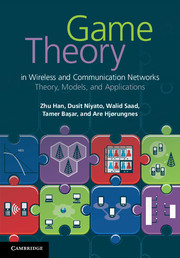
-
Select format
-
- Publisher:
- Cambridge University Press
- Publication date:
- 25 October 2011
- 20 October 2011
- ISBN:
- 9780511895043
- 9780521196963
- Dimensions:
- (247 x 174 mm)
- Weight & Pages:
- 1.08kg, 554 Pages
- Dimensions:
- Weight & Pages:
- Subjects:
- Communications and Signal Processing, Engineering
You may already have access via personal or institutional login- Subjects:
- Communications and Signal Processing, Engineering
Book description
This unified treatment of game theory focuses on finding state-of-the-art solutions to issues surrounding the next generation of wireless and communications networks. Future networks will rely on autonomous and distributed architectures to improve the efficiency and flexibility of mobile applications, and game theory provides the ideal framework for designing efficient and robust distributed algorithms. This book enables readers to develop a solid understanding of game theory, its applications and its use as an effective tool for addressing wireless communication and networking problems. The key results and tools of game theory are covered, as are various real-world technologies including 3G networks, wireless LANs, sensor networks, dynamic spectrum access and cognitive networks. The book also covers a wide range of techniques for modeling, designing and analysing communication networks using game theory, as well as state-of-the-art distributed design techniques. This is an ideal resource for communications engineers, researchers, and graduate and undergraduate students.
Reviews
'… a homogeneous collection of contributions in the field … logically fluid, without an overwhelming load of formalism and axiomatic approaches that are, too often, offered by books on game theory aimed at engineers. We are convinced that the work will become a reference book for graduate students and network engineers interested in the design of future communication network protocols.'
Source: IEEE Communications Magazine
Contents
Metrics
Full text views
Full text views help Loading metrics...
Loading metrics...
* Views captured on Cambridge Core between #date#. This data will be updated every 24 hours.
Usage data cannot currently be displayed.
Accessibility standard: Unknown
Why this information is here
This section outlines the accessibility features of this content - including support for screen readers, full keyboard navigation and high-contrast display options. This may not be relevant for you.
Accessibility Information
Accessibility compliance for the PDF of this book is currently unknown and may be updated in the future.


